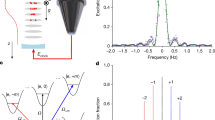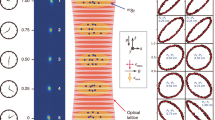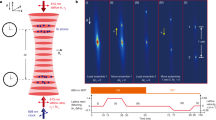Abstract
Time dilation is one of the most fascinating aspects of special relativity as it abolishes the notion of absolute time. It was first observed experimentally by Ives and Stilwell in 1938 using the Doppler effect. Here we report on a method, based on fast optical atomic clocks with large, but different Lorentz boosts, that tests relativistic time dilation with unprecedented precision. The approach combines ion storage and cooling with optical frequency counting using a frequency comb. 7Li+ ions are prepared at 6.4% and 3.0% of the speed of light in a storage ring, and their time is read with an accuracy of 2×10−10 using laser saturation spectroscopy. The comparison of the Doppler shifts yields a time dilation measurement represented by a Mansouri–Sexl parameter  , consistent with special relativity. This constrains the existence of a preferred cosmological reference frame and CPT- and Lorentz-violating ‘new’ physics beyond the standard model.
, consistent with special relativity. This constrains the existence of a preferred cosmological reference frame and CPT- and Lorentz-violating ‘new’ physics beyond the standard model.
This is a preview of subscription content, access via your institution
Access options
Subscribe to this journal
Receive 12 print issues and online access
$209.00 per year
only $17.42 per issue
Buy this article
- Purchase on Springer Link
- Instant access to full article PDF
Prices may be subject to local taxes which are calculated during checkout


Similar content being viewed by others
References
Einstein, A. Zur Elektrodynamik bewegter Körper. Ann. Phys. 322, 891–921 (1905).
Ashby, N. Relativity in the global positioning system. Living Rev. Relativity 6, 1 (2003).
Reichenbach, H. Relativitätstheorie und Erkenntnis apriori (Julius Springer, Berlin, 1920).
Pauli, W. On the conservation of the lepton charge. Il Nuovo Cimento 6, 204–215 (1957).
Greenberg, O. W. CPT violation implies violation of Lorentz invariance. Phys. Rev. Lett. 89, 231602 (2002).
Kostelecký, V. A. & Samuel, S. Spontaneous breaking of Lorentz symmetry in string theory. Phys. Rev. D 39, 683–685 (1989).
Amelino-Camelia, G., Ellis, J., Mavromatos, N. E., Nanopoulos, D. V. & Sarkar, S. Tests of quantum gravity from observations of gamma-ray bursts. Nature 393, 763–765 (1998).
Gambini, R. & Pullin, J. Nonstandard optics from quantum space-time. Phys. Rev. D 59, 124021 (1999).
Einstein, A. Über die Möglichkeit einer neuen Prüfung des Relativitätsprinzips. Ann. Phys. 328, 197–198 (1907).
Ives, H. E. & Stilwell, G. R. An experimental study of the rate of a moving atomic clock. J. Opt. Soc. Am. 28, 215–226 (1938).
Lämmerzahl, C. Special relativity and Lorentz invariance. Ann. Phys. 14, 71–102 (2005).
Mattingly, D. Modern tests of Lorentz invariance. Living Rev. Relativity 8, 5 (2005).
Robertson, H. P. Postulate versus observation in the special theory of relativity. Rev. Mod. Phys. 21, 378–382 (1949).
Mansouri, R. & Sexl, R. U. A test theory of special relativity: III. Second-order tests. Gen. Rel. Grav. 8, 809–814 (1977).
Stanwix, P. L., Tobar, M. E., Wolf, P., Locke, C. R. & Ivanov, E. N. Improved test of Lorentz invariance in electrodynamics using rotating cryogenic sapphire oscillators. Phys. Rev. D 74, 081101 (2006).
Wolf, P. et al. Whispering gallery resonators and tests of Lorentz invariance. Gen. Rel. Grav. 36, 2351–2372 (2004).
Will, C. M. Clock synchronization and isotropy of the one-way speed of light. Phys. Rev. D 45, 403–411 (1992).
Kretzschmar, M. Doppler spectroscopy on relativistic particle beams in the light of a test theory of special relativity. Z. Phys. A 342, 463–469 (1992).
Amelino-Camelia, G. Special treatment. Nature 418, 34–35 (2002).
Snyder, J. J. & Hall, J. L. in Lecture Notes in Physics Vol. 43 (ed. Haroche, S. et al.) (Springer, New York, 1975).
McGowan, R. W., Giltner, D. M., Sternberg, S. J. & Lee, S. A. New measurement of the relativistic Doppler shift in neon. Phys. Rev. Lett. 70, 251–254 (1993).
Gwinner, G. Experimental tests of time dilation in special relativity. Mod. Phys. Lett. A 20, 791–805 (2005).
Riis, E. et al. Lamb shifts and hyperfine structure in 6Li+ and 7Li+: Theory and experiment. Phys. Rev. A 49, 207–220 (1994).
Saathoff, G. et al. Improved test of time dilation in special relativity. Phys. Rev. Lett. 91, 190403 (2003).
Rong, H., Grafström, S., Kowalski, J., Neumann, R. & zu Putlitz, G. A new precise value of the absolute 2 3S1,F=5/2−2 3P2,F=7/2 transition frequency in 7Li+. Eur. Phys. J. D 3, 217–222 (1998).
Udem, Th., Holzwarth, R. & Hänsch, T. W. Optical frequency metrology. Nature 416, 233–237 (2002).
Reinhardt, S. et al. Iodine hyperfine structure and absolute frequency measurements at 565, 576, and 585 nm. Opt. Commun. 261, 282–290 (2006).
Artoni, M., Carusotto, I. & Minardi, F. Light-force-induced fluorescence line-center shifts in high-precision optical spectroscopy: Simple model and experiment. Phys. Rev. A 62, 023402 (2000).
Riis, E. et al. Test of the isotropy of the speed of light using fast-beam laser spectroscopy. Phys. Rev. Lett. 60, 81–84 (1988).
Wolf, P. & Petit, G. Satellite test of special relativity using the global positioning system. Phys. Rev. A 56, 4405–4409 (1997).
Hohensee, M., Glenday, A., Li, C.-H., Tobar, M. E. & Wolf, P. Erratum: New methods of testing Lorentz violation in electrodynamics. Phys. Rev. D 75, 049902 (2007).
Lane, C. D. Probing Lorentz violation with Doppler-shift experiments. Phys. Rev. D 72, 016005 (2005).
Acknowledgements
Technical support from M. Grieser, K. Horn and H. Krieger is gratefully acknowledged.
Author information
Authors and Affiliations
Corresponding author
Rights and permissions
About this article
Cite this article
Reinhardt, S., Saathoff, G., Buhr, H. et al. Test of relativistic time dilation with fast optical atomic clocks at different velocities. Nature Phys 3, 861–864 (2007). https://doi.org/10.1038/nphys778
Received:
Accepted:
Published:
Issue Date:
DOI: https://doi.org/10.1038/nphys778
This article is cited by
-
Experimentally confirming the special relativistic properties of Coulomb fields
Nature Physics (2022)
-
Ultrafast visualization of an electric field under the Lorentz transformation
Nature Physics (2022)
-
Quantum clocks observe classical and quantum time dilation
Nature Communications (2020)
-
The Doppler Effect and the Anisotropy of the Speed of Light
Foundations of Physics (2020)
-
Quantum formulation of the Einstein equivalence principle
Nature Physics (2018)



